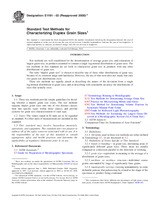We need your consent to use the individual data so that you can see information about your interests, among other things. Click "OK" to give your consent.
ASTM E1181-02(2008)e1
Standard Test Methods for Characterizing Duplex Grain Sizes (Includes all amendments And changes 11/5/2015).
Automatically translated name:
Standard Test Methods for Characterizing Duplex Grain Sizes
STANDARD published on 1.6.2008
The information about the standard:
Designation standards: ASTM E1181-02(2008)e1
Note: WITHDRAWN
Publication date standards: 1.6.2008
SKU: NS-580658
The number of pages: 15
Approximate weight : 45 g (0.10 lbs)
Country: American technical standard
Category: Technical standards ASTM
Annotation of standard text ASTM E1181-02(2008)e1 :
Keywords:
area fraction, banding, bands, duplex, grain size, necklace,, ICS Number Code 19.120 (Particle size analysis. Sieving)
Additional information
| Significance and Use | ||||||||||||||||
|
Duplex grain size may occur in some metals and alloys as a result of their thermomechanical processing history. For comparison of mechanical properties with metallurgical features, or for specification purposes, it may be important to be able to characterize grain size in such materials. Assigning an average grain size value to a duplex grain size specimen does not adequately characterize the appearance of that specimen, and may even misrepresent its appearance. For example, averaging two distinctly different grain sizes may result in reporting a size that does not actually exist anywhere in the specimen. These test methods may be applied to specimens or products containing randomly intermingled grains of two or more significantly different sizes (henceforth referred to as random duplex grain size). Examples of random duplex grain sizes include: isolated coarse grains in a matrix of much finer grains, extremely wide distributions of grain sizes, and bimodal distributions of grain size. These test methods may also be applied to specimens or products containing grains of two or more significantly different sizes, but distributed in topologically varying patterns (henceforth referred to as topological duplex grain sizes). Examples of topological duplex grain sizes include: systematic variation of grain size across the section of a product, necklace structures, banded structures, and germinative grain growth in selected areas of critical strain. These test methods may be applied to specimens or products regardless of their state of recrystallization. Because these test methods describe deviations from a single, log-normal distribution of grain sizes, and characterize patterns of variation in grain size, the total specimen cross-section must be evaluated. These test methods are limited to duplex grain sizes as identifiable within a single polished and etched metallurgical specimen. If duplex grain size is suspected in a product too large to be polished and etched as a single specimen, macroetching should be considered as a first step in evaluation. The entire macroetched cross-section should be used as a basis for estimating area fractions occupied by distinct grain sizes, if possible. If microscopic examination is subsequently necessary, individual specimens must be taken to allow estimation of area fractions for the entire product cross-section, and to allow determination of grain sizes representing the entire cross-section as well. These test methods are intended to be applied to duplex grain sizes. Duplex grain structures (for example, multiphase alloys) are not necessarily duplex in grain size, and as such are not the subject of these methods. However, the test methods described here for area fraction estimation may be of use in describing duplex grain structures. |
||||||||||||||||
| 1. Scope | ||||||||||||||||
|
1.1 These test methods provide simple guidelines for deciding whether a duplex grain size exists. The test methods separate duplex grain sizes into one of two distinct classes, then into specific types within those classes, and provide systems for grain size characterization of each type. 1.2 Units—The values stated in SI units are to be regarded as standard. No other units of measurement are included in this standard. 1.3 This standard may involve hazardous materials, operations, and equipment. This standard does not purport to address all of the safety concerns associated with its use. It is the responsibility of the user of this standard to consult appropriate safety and health practices and determine the applicability of regulatory limitations prior to its use. |
||||||||||||||||
| 2. Referenced Documents | ||||||||||||||||
|
We recommend:
Updating of laws
Do you want to be sure about the validity of used regulations?
We offer you a solution so that you could use valid and updated legislative regulations.
Would you like to get more information? Look at this page.




 Cookies
Cookies
